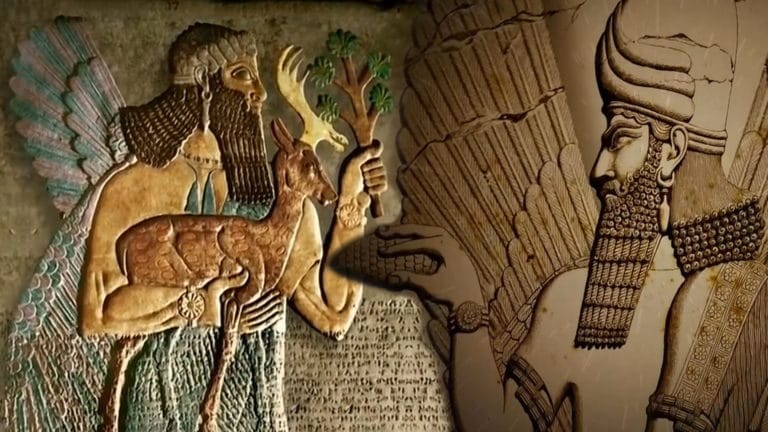They may have lived thousands of years before us, but the ancient Sumerians left behind a treasure trove of their existence, from towering ziggurats to stone tablets containing their cuneiform writing system. This civilization has proven itself to have once walked the Earth, even if they did disappear entirely from history.
We also know that the Sumerians had a unique collection of mythologies – ones that, for many, contain clues of an extraterrestrial race.
In this article, we’re taking a deep dive into the Anunnaki – an alien race inextricably linked with the ancient Sumerian civilization of Mesopotamia. For many, these extraterrestrial beings not only masqueraded as gods but are also the reason why human DNA contains genetic material that isn’t of this world.
Creation Myths Around The World
The origin of the universe has long been a source of fascination for us. Science tells us that before there were celestial beings and living organisms, there was a big bang or an explosion of such a massive scale, that it ended up creating the world as we know it.
Meanwhile, the Japanese creation myth starts with chaos. In this story, a shapeless chunk of matter suddenly saw movement, which led to the creation of the “Takamagahara” or the “High Plain of Heaven.” From this came five gods and eventually, the rest of the universe.
There are a ton of creation myths, each one bearing its own set of unique deities and fantastical circumstances. As beautiful and as interesting as they are, many of us believe that these are mere stories – legends and folktales that our grandparents read to us when we were young.
But for our ancient forefathers, these creation myths were more than just stories. For them, these held undeniable truths and secrets of the universe. Not only did such tales allow them to understand the world that they lived in, but they also enabled them to gain more insight into their identities.
And, perhaps no other creation myth embodies this more than the one told by the Sumerians of ancient Mesopotamia.
The Sumerians of Ancient Mesopotamia
Before dissecting the Sumerian creation myth and how it relates to us, modern-day humans, it’s first important to understand who these people were.
Thanks to the Tigris-Euphrates river system, their communities enjoyed incredibly fertile lands that made farming and harvesting crops easy. The sheer amount of resources that the region provided them with eventually allowed the Sumerians to dominate the ancient world.
Uruk, one of its city-states, even became a thriving trading hub. At one point, it was the largest city in the entire world, boasting of a population of at least 40,000, as well as defensive walls and fortifications that ran for over six miles.
This civilization is also known for its elaborate architecture, which encompasses breathtaking mosaics, towering brick columns, grandiose palaces, and pyramid-like stepped temples referred to as “ziggurats.”
But arguably one of the most fascinating aspects of ancient Sumerian civilization was the religion that they practiced. Their anthropomorphic polytheism faith led to each city-state worshiping their own deities. There was a core pantheon, though, which consisted of “An” or “Heaven,” as well as “Utu the Sun-God” and “Sin the Moon-God,” among others.
This is undoubtedly the reason why the Sumerian creation myth was found buried in this city. Painstakingly carved in cuneiform, the story begins like this,
“When in the height heaven was not named / And, the earth beneath did not yet bear a name / And, the primeval Apsu who begat them / And, chaos, Tiamut, the mother of them both / Their waters mingled together, / And, no field was formed, no marsh was to be seen; / When of the gods none had been called into being, / And, none bore a name, and no destinies were ordained; / Then were created the gods in the midst of heaven / Lahmu and Lahamu were called into being.”
The myth goes on to claim that the gods came to earth to transform the once-uninhabitable place into a paradise. Toiling day and night, it mined its minerals and gathered its resources, working like human beings instead of the divine deities that they were.
However, this creation myth wasn’t the only thing that the cuneiform tablets revealed. Rather, they also told peculiar stories of how the gods ended up engaging with the human beings that they initially sought out to subjugate. Not only were they forced to carry out backbreaking labor on behalf of the divine deities, but they were also made to strictly abide by the rules that had been set out for them.
The Anunnaki Alien Race
The stone tablets allegedly called these gods the “Anunnaki”, which means “those who came from the heavens”. Many claim that they were nothing more than myths – akin to Zeus, Osiris, and the rest of the deities that the ancient world worshiped.
But others believe differently. For them, the Anunnaki were actual, tangible beings, who came from the mysterious and faraway “Planet X” or “Nibiru” – a celestial body that passed Earth millennials ago. Its residents traveled to our world for what was initially a quick visit but ultimately ended up staying after witnessing the vast resources that we had.

According to an article published by Wonderopolis,
“Some even go so far as to say the Anunnaki were a species of reptilian humanoids. They believe these reptiles helped the Sumerians develop their systems of writing and mathematics. Further, they think the reptiles are still around today and wield power in the human world.”
But rather than slavers and masters, the Anunnaki race was held by the Sumerians to be their gods; more specifically, as the children of the Earth and Sky, who deserved to be worshiped, venerated, and praised. This ancient civilization believed that the knowledge and wisdom bestowed to them by these otherworldly creatures were worth the grueling forced labor that they were made to carry out.
This influence has long been perceived as the reason why the Assyrians held supernatural and mystical forces in high regard. For instance, the gates of their cities were adorned with statues of “genii,” who purportedly protected all those within the walls. Their images show them as winged creatures with beards and pine cones, from which blessings – in the form of water – flowed out.
The Assyrians were also staunch believers in omens and often employed diviners to communicate with their gods. These individuals would read the bumps and grooves on a sheep’s liver, which they claimed were actually divine messages.
However, other researchers further claim that rather than chancing upon human beings on Earth, the Anunnaki created our race for the sole purpose of mining the planet’s resources for them. Once this goal was achieved and man had finished serving its purpose, they were left behind to die off.
Humans – The Slave Race of the Anunnaki
This idea is undoubtedly compelling, but it would also explain why there are certain weak and unexplainable gaps in the theory of evolution.
Additionally, this also paved the way for the theory that human DNA actually contains traces of alien compounds.
After all, when the Anunnaki created man, the only genetic material that they had access to were the ones they had themselves.
For instance, some claim that the other unexplainable structures seen on our planet are actually products of Anunnaki engineering and architecture. Rather than attribute all the mysterious pyramids around the world to ancient civilizations, they instead credit the alien race.
Another theory about the Anunnaki is that they didn’t leave planet Earth after obtaining all the gold and resources that they wanted. Rather, many people believe that this alien race continues to manipulate and influence humanity and its various sectors, from politics to corporate and finance.
Many share these beliefs. For them, the Anunnaki aren’t completely gone from this world. Rather, they continue controlling us, playing with our fates, and subjecting us to their every whim.


